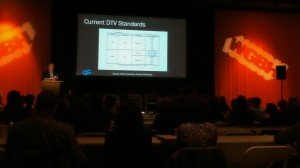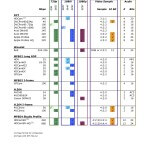Part 03 of the PBS Quality Group Workshops…
Overview
Dave MacCarn started off as the Director of Engineering at WGBH in 1985, and currently serves as the Chief Technologist for the WGBH Educational Foundation. He’s responsible for long term planning, investment, and adoption of new technologies.
Links & Materials…
- Slides from the talk are available here (.pdf).
- HD Acquisition Codecs – Chart summarizing the family of codecs widely used today. Doesn’t talk about containers though (Quicktime, AVI, MXF, etc.)
- DTV Standards
Key Takeaways…
In many cases, you are dealing with 1.2 Gigabits/second of data you want to capture for every second of shooting. Do you really understand what happens when you compress that down to 25 Megabits/second in the recorder? Need to factor in the content before compressing, i.e. is it mainly talking heads, or is it a huge battlefield?
With the analog to digital to HD transition, there’s been an explosion of formats, each with different compression techniques and containers involved. Some of the information you need to be aware of can’t be found in data sheets. Marketing from camera vendors has led to an unclear message as to what the true recording format is that you’re going to get. Here are a few considerations for what to look for, especially when it comes to data reduction.
Data Reduction Techniques
There are 3 common methods for reducing data:
- Resolution sub-sampling
- Video encoding/sampling
- Video compression
Resolution Sub-Sampling
- 1920 horizontal pixels reduced to 1280
- DVCProHD-1080i
- 1920 reduced to 1440
- HDCam, HDV, XDCamHD, XDCamEX (25Mbps), AVCIntra (50Mbps – 1080i)
- 1280 reduced to 960
- DVCProHD-720p, AVCIntra (50Mbps – 720p)
- Good way of reducing data while avoiding losing sharpness
Video Sampling
- Process where luma is sampled once (Y’), and chroma difference components are sampled each (Cb’ and Cr’)
- Human vision is less sensitive to reduction in chroma than luma, so reducing chroma samples from 4:4:4 down to 3:1:1 is a good way of reducing data
- Examples of 4:2:0 sampling are HDV, XDCamHD, AVCHD, and Canon 5D
Video Compression
Many different compression techniques used by today’s devices. An excellent summary of HD acquisition codecs in use today is provided in the following table:
Here are some of the effects these have on data reduction and image quality:
- DCT (discrete cosine transform)
- Compresses each frame of video, frame by frame
- Makes the picture blocky over time
- Wavelet transform
- Relatively new and promising
- Frame based
- Softens the picture instead of making it blocky
- Computationally intense
- MPEG
- MPEG-2 well known
- 2 types: I-frame and Long GOP (LGOP)
- LGOP is compression across multiple frames
- LGOP needs rendering when edited
- H.264 (AVC)
- MPEG-4 advanced video encoding
- Comparable quality as MPEG-2 at low bit rates but requires more processing power
- Used by AVCHD and Canon 5D MK II
- I-frame version used by AVCIntra
- MPEG4 Studio Profile
- Very high bit rate (400-800 Mbps)
- Uses both inter-frame and intra-frame coding
- Used by HDCamSR and HDCamSR-HQ
- Uses tape media
Recording Systems
The last consideration is recording media and storage. For recording media, there are 3 categories:
- Optical disks
- Bluray
- Inexpensive, but lower transfer rates.
- Hard drives
- Transfer very quickly, but vulnerable to damage
- Solid state memory cards
- Robust and high transfer rates, but recording time is limited and cost is high
For backups and archival, common IT 3-2-1 data storage practices prevail, i.e. 3 copies, on 2 different mediums, plus 1 off site. For long-term storage:
- Solid state is too expensive
- HDs are getting cheaper
- Data tape (LTO5)



